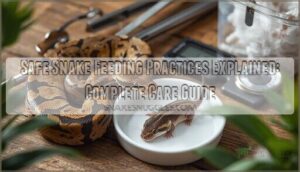This site is supported by our readers. We may earn a commission, at no cost to you, if you purchase through links.

A proper snake diet for digestion issues starts with temperature control, since snakes can’t digest food below 80°F.
You’ll need appropriately sized prey (no wider than your snake’s thickest part), consistent feeding schedules, and stress-free environments.
Frozen-thawed prey often works better than live food for sensitive stomachs, while maintaining proper humidity prevents dehydration-related constipation.
The real game-changer involves understanding how environmental factors work together to create the perfect digestive conditions.
Table Of Contents
- Key Takeaways
- Common Snake Digestive Issues and Their Causes
- Optimal Prey Selection for Digestive Health
- Feeding Techniques to Prevent Digestive Problems
- Environmental Factors Affecting Snake Digestion
- Nutritional Supplements for Digestive Support
- Hydration Strategies for Optimal Digestion
- Recognizing Signs of Improved Digestive Health
- Specialized Diets for Snakes With Chronic Digestive Issues
- Veterinary Interventions for Severe Digestive Problems
- Preventive Measures for Long-term Digestive Health
- Frequently Asked Questions (FAQs)
- Does snake venom help with digestion?
- What is the healthiest food for snakes?
- Do snakes have slow digestion?
- What is the snake diet?
- What should I do if my snake eats its food?
- How does a snake digest food?
- Do snakes have a good digestive system?
- What do you eat on the Snake Diet?
- What is the snake method diet?
- What is a snakes diet plan?
- Conclusion
Key Takeaways
- Control temperature precisely – Keep basking spots at 88-92°F and cool zones at 75-80°F, since snakes cannot digest food below 80°F, making temperature the most critical factor for proper digestion.
- Choose frozen-thawed prey that’s properly sized – Select prey no wider than your snake’s thickest body part and weighing 10-15% of their body weight to prevent regurgitation and digestive stress.
- Maintain proper humidity and hydration – Keep humidity between 40-70% and provide clean water bowls, as dehydration causes constipation and blocks normal digestive processes.
- Create a stress-free feeding environment – Avoid handling for 48 hours after feeding, maintain consistent schedules, and provide multiple hiding spots to prevent stress-related digestive issues, such as regurgitation.
Common Snake Digestive Issues and Their Causes
Your snake’s digestive troubles often stem from stress, improper temperatures, or poor feeding practices that you can fix with the right approach.
Understanding these common issues—from regurgitation to parasites—helps you spot problems early and take action before they become serious health concerns.
Regurgitation and Vomiting
When your snake’s meal makes an unexpected comeback, don’t panic.
Regurgitation and vomiting typically result from stress factors like improper handling, temperature fluctuations, or feeding too soon after meals.
Vomiting causes include environmental changes and food rejection from illness. Watch for regurgitation signs like undigested prey appearing hours after feeding.
Your snake’s gut health depends on maintaining proper temperatures and minimizing disturbances. Consider digestive enzymes if digestion problems persist, and remember that addressing your snake diet for digestion issues starts with creating a calm, stable environment.
Constipation and Impaction
While regurgitation grabs attention with its dramatic display, constipation and impaction silently wreak havoc on your snake’s digestive health. These conditions develop when dehydration causes hardened waste or substrate blocks your pet’s system.
Watch for these warning signs of constipation:
- Loss of appetite lasting weeks
- Visible straining without results
- Hard, swollen belly area
- Lethargy and reduced movement
- Urates without feces production
Impaction prevention starts with proper hydration and safe substrates. Boost your snake’s gut health through warm soaks and increased water availability. Though snakes don’t need fiber intake like mammals, maintaining ideal moisture levels provides natural constipation relief and prevents dangerous blockages.
Understanding common digestive issues is vital for identifying the root causes of these problems.
Parasitic Infections
While blockages cause obvious problems, tiny invaders can be just as devastating to your snake’s digestive health.
Parasitic infections create a nightmare scenario where your pet suffers from chronic discomfort and declining condition.
These microscopic troublemakers attack your snake’s intestinal tract and gut microbiome:
- Cryptosporidium – causes severe stomach swelling and endless digestive turmoil
- Roundworms – trigger violent regurgitation episodes that weaken your snake
- Snake Mites – drain blood while spreading secondary infections throughout the body
- Hookworms – create painful intestinal damage leading to malnutrition
Infection Signs include watery stools, unexplained weight loss, and loss of appetite.
Parasite Control requires immediate veterinary intervention and regular fecal testing to protect your snake’s digestive health from these relentless invaders.
Metabolic Bone Disease
Beyond parasitic infections, calcium deficiency creates another serious threat to your snake’s health.
Metabolic bone disease weakens your pet’s skeletal structure, causing bone fragility and movement difficulties.
Without proper UVB lighting and nutritional balance, your snake can’t absorb calcium effectively.
Dietary supplements containing calcium and vitamin D3 support skeletal health when combined with appropriate lighting.
| Risk Factor | Signs | Prevention |
|---|---|---|
| Calcium Deficiency | Soft bones, deformities | Calcium and vitamin D3 supplements |
| Poor UVB exposure | Weakness, tremors | Proper UVB lighting schedule |
| Nutrient deficiencies | Rubbery jaw, fractures | Digestive enzymes, balanced diet |
| Inadequate supplements | Reduced mobility | Regular dietary supplements |
Anorexia and Appetite Loss
When your snake refuses food, appetite loss signals deeper digestion issues that need attention.
Your snake’s refusal to eat screams trouble—don’t ignore this digestive red flag.
Stress factors like handling, environmental changes, or improper temperatures often trigger anorexia in snakes.
Pregnancy effects and shedding cycles naturally reduce feeding interest, while parasites or nutrient deficiency create lasting digestive problems.
Smart appetite stimulation through proper husbandry gets your snake back on track.
- Monitor temperature gradients to confirm proper snake digestion and metabolic function
- Reduce handling during shedding periods when appetite naturally decreases
- Check for parasites or infections causing persistent feeding refusal
- Maintain consistent feeding schedules to encourage regular appetite patterns
Optimal Prey Selection for Digestive Health
Choosing the right prey directly impacts your snake’s digestive health and can prevent common problems like regurgitation or impaction.
Smart prey selection means picking frozen over live options, getting the size just right, and ensuring proper nutritional balance for your slithery friend’s gut.
Frozen Vs. Live Prey
Frozen vs live prey – it’s the age-old debate that keeps snake owners up at night!
Frozen benefits clearly win for prey safety and digestive health. While live prey risks include injury and parasite transmission, frozen options eliminate these dangers.
Your feeding methods become simpler with consistent nutrition and safer prey handling. Most snakes adapt to frozen prey, supporting better snake digestion overall.
The use of frozen mouse prey is a popular choice for many snake owners due to its convenience and nutritional value.
Prey Size and Frequency
Getting the prey size right prevents digestive hitches – think of it as finding your snake’s perfect portion.
Young snakes need meals every 5-7 days, while adults can wait 10-14 days between feedings.
Appropriately-sized prey should match your snake’s widest body part, never exceeding 10% of their weight.
These feeding schedules support healthy snake digestion and prevent overloading their system, which is crucial for maintaining a snake’s overall well-being.
Nutritional Balance Considerations
Anyone can achieve ideal snake nutrition with the right nutritional balance considerations.
Your snake’s protein sources should match their natural diet, while you’ll need to monitor vitamin needs and mineral balance carefully.
Proper caloric intake prevents digestive stress that leads to serious health problems.
Focus on these key nutritional elements:
- Calcium-phosphorus ratio: Maintain 1.5:1 to 2:1 for strong bones and smooth digestion
- Gut-loaded prey: Enhances nutrient absorption with essential trace minerals like zinc and iron
- Varied protein sources: Prevents nutritional deficiencies while supporting healthy metabolism
Smart snake nutrition means understanding nutrient ratios work together like puzzle pieces.
When you get the balance right, you’re preventing digestion issues before they start.
Think of yourself as your snake’s personal chef – every meal should deliver complete nutrition that supports their digestive system and overall health.
Ensuring the right snake nutritional health is vital for a long and healthy life.
Feeding Techniques to Prevent Digestive Problems
You’ll dramatically improve your snake’s digestive health by mastering the right feeding techniques – it’s like learning the secret handshake that keeps their gut happy.
Think of these methods as your toolkit for preventing those midnight worry sessions when your snake refuses to eat or has digestive troubles, which can be a significant concern for any snake owner, and thus, understanding these techniques is crucial for a snake’s overall health.
Proper Prey Size and Temperature
Now you’ve got the feeding schedule down, let’s nail the sizing and Temperature Control fundamentals. Your snake’s Digestive Health depends on appropriatelysized prey that won’t cause gut inflammation or digestive stress.
Prey Measurement Guidelines:
- Match prey width to your snake’s thickest body section – like finding the perfect shoe size
- Choose frozen rodents weighing 10-15% of your snake’s total body weight
- Avoid oversized meals that sit like rocks in your pet’s stomach
- Select prey with soft bones for easier breakdown and Snake Nutrition absorption
Thaw frozen prey overnight in your refrigerator, then warm to 98-100°F using warm water. This temperature mimics fresh kills and triggers natural Feeding Guidelines responses, preventing rejection and supporting ideal prey size and frequency patterns.
Handling and Presenting Food
Master food presentation by using feeding tongs – they’ll keep your fingers safe while mimicking natural hunting behaviors.
Prey thawing matters: warm frozen meals to body temperature for better acceptance.
Handling prey correctly means never hand-feeding, which confuses snakes about what’s food versus fingers.
| Feeding Technique | Safety Benefit | Snake Response |
|---|---|---|
| Food tongs | Prevents bites | Natural hunting trigger |
| Food temperature warming | Easier digestion | Increased appetite |
| Separate feeding area | Reduces aggression | Less territorial behavior |
| Consistent feeding techniques | Builds routine | Reduces stress |
| Proper handling and presenting food | Prevents confusion | Clear meal boundaries |
Smart feeding safety creates happy, healthy snakes.
Understanding proper feeding methods is essential for a snake’s overall health and digestion.
Post-feeding Care and Monitoring
After proper food presentation, your snake’s gastrointestinal tract needs careful postfeeding care.
Watch for these key signs during the snake digestion process:
- Normal feeding response – your snake should swallow prey completely within minutes
- Digestion time – expect 3-7 days for complete food intake processing
- Health checks – monitor for regurgitation or unusual behavior during snake observation
- Temperature maintenance – keep basking spots consistent to support proper snake health monitoring
Don’t handle your snake for 48 hours after feeding to prevent digestion issues.
Adjusting Feeding Frequency
Nailing the right feeding schedules takes some trial and error, but your snake’s age is your best starting point.
Young snakes burn through calories faster and need meals every 5-7 days, while adults can go 10-14 days between feedings.
Watch your snake’s body condition closely – a chunky middle means you’re overdoing it.
Digestion cycles slow down in cooler weather, so adjust your meal timing accordingly.
Snake growth patterns also shift feeding needs, requiring more frequent meals during growth spurts.
Avoiding Overfeeding
Overfeeding frequently creates more digestive problems than underfeeding ever will. Your snake doesn’t need daily meals like your dog—think marathon runner, not sprinter.
Excess food portions can lead to snake obesity and serious digestion issues that compromise your pet’s health.
Follow these feeding limits for proper digestive care:
- Stick to prey that’s 10-15% of your snake’s body weight maximum
- Space meals 10-14 days apart for adults, 5-7 days for juveniles
- Monitor body condition—you shouldn’t see rolls or obvious fat deposits
- Adjust portions during shedding cycles when appetite control naturally decreases
Remember, a slightly hungry snake is healthier than an overstuffed one. Optimal feeding practices focus on consistency over abundance for long-term snake diet success.
Environmental Factors Affecting Snake Digestion
Your snake’s environment plays a vital role in proper digestion, often determining whether your pet thrives or struggles with ongoing digestive issues.
Getting the temperature, humidity, and lighting right can transform a finicky eater into a healthy snake with regular bowel movements.
Temperature Gradient and Basking Spots
Think of heat lamps as your snake’s personal sun that powers digestion like a furnace.
Create thermal gradients with basking spots at 88-92°F and cool zones at 75-80°F.
This temperature control lets your pet move between zones, optimizing metabolism for breaking down meals.
Poor heat sources cause snake digestion issues, while proper environmental factors keep that belly working smoothly.
Your serpent becomes a happy, efficient eating machine!
Maintaining vital temperature gradients is essential for healthy digestion and overall well-being.
Humidity Levels and Hydration
Everyone knows hydration affects everything—including your snake’s Humidity Control and Snake Hydration.
Keep Moisture Levels between 40-70% using digital hygrometers. Water Quality matters: use clean, room-temperature water in heavy ceramic bowls.
Watch for Dehydration Signs like skin tenting. Misting Techniques work great for tropical species, while Soaking Routines help during shedding.
Proper water bowl placement away from heat sources prevents rapid evaporation.
Stress Reduction Techniques
Why does stress wreak havoc on your snake’s digestive system? When your pet feels anxious, its stress response triggers dehydration and digestive adjustments that disrupt normal feeding patterns.
Environmental Enrichment creates a sanctuary where your snake feels secure:
- Add multiple hiding spots using caves, logs, or commercial hides
- Maintain consistent Temperature Control and Humidity Management to prevent stress spikes
- Use Calming Aids like dim lighting and minimal noise during feeding times
Gentle Handling Techniques matter too. Avoid sudden movements and establish predictable routines. Your hydration strategies work better when stress stays low, creating the perfect recipe for digestive success.
UVB Lighting for Vitamin D3 Synthesis
Your snake needs UVB lighting for healthy vitamin D3 synthesis, even if they’re nocturnal.
Position UVB lights 9-15 inches from basking spots to boost calcium absorption and prevent metabolic bone disease.
| UVB Setup | Benefits |
|---|---|
| 9-15 inch distance | Ideal vitamin D3 production |
| 10-12 hour cycles | Mimics natural lighting patterns |
| Full-spectrum bulbs | Enhanced reptile health |
| Regular replacement | Maintains UV output |
| Timer controls | Consistent lighting cycles |
Even night-dwelling noodles benefit from this artificial sunshine for proper reptile nutrition and snake digestion.
Substrate Choices and Ingestion Risks
Why choose the wrong substrate and risk your snake’s life? Substrate Safety starts with understanding Ingestion Dangers that lead to Digestive Blockages. Smart Snake Substrates prevent Ingestion Risks while supporting natural behaviors.
Your substrate choices directly impact digestive health. Paper towels and newspaper eliminate substrate ingestion concerns, requiring fewer digestive adjustments than risky alternatives. Even with proper gutloading, ingestion risks remain serious.
Consider these safe options:
- Paper towels for easy cleaning and zero ingestion risk
- Newspaper for cost-effective, digestible-free bedding
- Large river rocks over soil for naturalistic appeal
- Cypress mulch for species requiring higher humidity
Choose substrates that protect rather than threaten your snake’s digestive system.
Nutritional Supplements for Digestive Support
When your snake’s digestive system needs extra help, targeted supplements can make all the difference.
Think of these additions as your snake’s nutritional safety net – they fill gaps and boost gut health when regular prey isn’t quite enough.
Calcium and Vitamin D3 Supplementation
Building bone strength in your snake requires the perfect calcium and Vitamin D3 partnership.
Without adequate calcium, your pet faces serious bone health problems that’ll make movement painful. Vitamin D3 acts like a key, facilitating nutrient absorption so calcium actually reaches those bones.
Proper calcium intake is vital for preventing issues related to calcium deficiencies.
Bone health
Vitamin D3 Calcium absorption
Balance matters most—too much creates problems just like too little does.
Probiotics for Gut Health
Introducing probiotics into your snake’s diet can revolutionize their digestive health by restoring Microbe Balance and promoting Healthy Bacteria growth.
These microscopic allies offer remarkable Probiotic Benefits for reptiles struggling with digestive troubles.
Consider these proven probiotic strategies for Digestive Aid:
- Bacillus subtilis and Lactobacillus acidophilus survive reptile gut conditions effectively
- Dosage of 1.0-1.5 million CFUs per kilogram body weight weekly
- Apply directly to prey items before feeding for ideal absorption
- Enterococcus faecium helps balance intestinal microbial populations naturally
- Multi-species blends maximize Gut Flora resilience and digestive efficiency.
Research shows probiotics reduce regurgitation rates by 40% while supporting Healthy Digestion through improved protein absorption and faster transit times.
Digestive Enzymes
While probiotics lay the foundation for healthy gut bacteria, Enzyme Supplements can supercharge your snake’s Protein Digestion. These powerful Digestive Aids tackle Enzyme Deficiency head-on, breaking down meals more efficiently.
| Enzyme Type | Function |
|---|---|
| Protease | Breaks down proteins |
| Amylase | Processes carbohydrates |
| Lipase | Digests fats |
When your snake’s stomach struggles with tough prey, these supplements boost enzyme activity for better nutrient absorption. Start with 1/8 teaspoon per 30 pounds of snake weight. Watch for improved Gut Health as digestive adjustments take effect—your scaly friend will thank you!
Multivitamin and Mineral Supplements
While digestive enzymes break down food components, your snake’s overall health depends on addressing broader nutritional gaps.
Multivitamin and mineral supplements act as nutrient boosters, filling dietary holes that whole prey might miss.
These supplements support your pet’s vitamin needs and mineral balance throughout their system.
You’ll find snake vitamins particularly helpful for preventing nutritional deficiencies that contribute to poor digestion.
Think of them as insurance for your snake’s health – they won’t fix everything, but they’ll cover the bases.
Supplement safety matters though.
Over-supplementation can backfire, causing more harm than good.
Choose reputable snake supplements designed specifically for reptiles, not generic pet vitamins.
Timing helps too – offer them after feeding when absorption peaks.
Remember, supplements complement good feeding practices rather than replace them.
Your snake’s digestion diversity benefits most from balanced nutrition, not vitamin overload.
Herbal Remedies for Digestive Aid
While multivitamins cover broad nutritional gaps, nature’s pharmacy offers gentle digestive aids for your scaly companion.
These natural soothers work like a warm blanket for troubled tummies, but veterinary approval comes first.
Ginger benefits include stimulating sluggish digestion, while peppermint oil eases gas buildup.
Chamomile tea calms inflammation, and fennel supports overall intestinal health.
Slippery elm creates protective mucilage for irritated digestive tracts, potentially helping with leaky gut issues.
These digestive herbs complement your snake diet for digestion issues strategy:
- Your snake deserves the same gentle care you’d give yourself
- Natural remedies honor your pet’s wellbeing without harsh chemicals
- Small doses create big comfort for suffering serpents
- Plant-based solutions connect you to ancient healing wisdom
- Herbal remedies offer hope when conventional methods fall short
Remember: less is more with these potent plant allies.
Hydration Strategies for Optimal Digestion
You’ll want to keep your snake properly hydrated since dehydration makes digestion sluggish and can lead to serious blockages.
Think of water as your pet’s digestive lubricant – without enough of it, food just sits there like a traffic jam in their stomach, which is why dehydration is a critical issue.
Water Bowl Placement and Maintenance
Your water-bowl strategy makes or breaks snake hydration success. Position a ceramic bowl at the cool end—it maintains Water Quality longer and prevents humidity spikes. Bowl Cleaning matters: rinse daily, deep-clean weekly with diluted vinegar. Water Depth should allow soaking without drowning risks.
| Water Bowl Factor | Best Practice | Why It Matters |
|---|---|---|
| Location | Cool end of enclosure | Prevents bacterial growth, controls Humidity Control |
| Material | Heavy ceramic dish | Won’t tip over, easy to sanitize |
| Size | Snake can coil inside | Supports natural soaking behavior |
| Depth | 1-2 inches maximum | Prevents drowning while allowing Snake Hydration |
Fresh standing water supports digestion—dehydrated snakes can’t process food properly. Clean water dish placement transforms your pet’s health from the inside out. Using the right ceramic water bowls is essential for maintaining a healthy environment.
Misting Techniques
Beyond water dishes, proper humidity control through misting techniques keeps your snake’s digestive system running smoothly.
You’ll want to create a gentle mist that mimics natural rainfall patterns.
Here’s how to master the misting game:
- Use room temperature water to avoid shocking your snake
- Mist 2-3 times daily during peak activity hours
- Target hide boxes and branches for even distribution
- Adjust fogging systems based on enclosure ventilation
- Monitor hydration methods with a reliable hygrometer
Smart misting schedules prevent standing water while maintaining ideal humidity levels for healthy digestion.
Soaking Routines
Your snake deserves proper Water Therapy just like any pet needing comfort.
Think of soaking as creating a mini spa experience that tackles multiple health needs simultaneously.
Fill a shallow container with lukewarm water (80-85°F) reaching only halfway up your snake’s body.
This soaking area becomes essential for Scale Care and Hydration Methods during times of stress or poor appetite.
Let your snake relax for 15-30 minutes once weekly, or more frequently if experiencing digestive issues.
The warm water provides gastrointestinal stimulation while supporting Humidity Control around the body.
This gentle Skin Soaking helps loosen stuck shed and promotes better circulation.
Monitor your pet closely during sessions – never leave them unattended.
The water level should allow easy breathing while submerged.
This simple husbandry practice helps optimize environment conditions that support natural digestive processes.
Many keepers notice improved appetite and regular bowel movements after implementing consistent soaking routines alongside proper digestive adjustments.
Electrolyte Solutions for Dehydrated Snakes
Creating effective electrolyte solutions can rescue your dehydrated snake from digestive distress.
Proper electrolyte balance supports snake hydration and helps combat dehydration signs like sunken eyes or lethargy.
Key electrolyte supplements for rehydration methods:
- Sodium chloride – restores cellular fluid balance
- Potassium – maintains muscle and nerve function
- Calcium – supports bone health and metabolism
- Glucose – provides energy for recovery
Always consult your vet before administering fluid therapy for serious digestive issues.
Monitoring Urates for Hydration Status
Keep tabs on your snake’s urates to gauge hydration status. You’ll spot dehydration when urates appear bright white and chalky. Healthy snakes produce pasty, cream-colored urates.
Kidney function relies on proper fluid balance, so regular urate analysis helps prevent urinary issues and supports digestive health.
| Urate Color | Consistency | Hydration Levels |
|---|---|---|
| Bright white | Chalky/powdery | Dehydrated |
| Cream/off-white | Pasty/thick | Normal |
| Very pale | Gel-like | Well-hydrated |
Electrolyte management becomes essential when monitoring urates reveals problems. Adjust electrolyte solutions based on what you observe.
Recognizing Signs of Improved Digestive Health
After making dietary changes for your snake, you’ll want to watch for key signs that show their digestive system is bouncing back.
Look for regular, well-formed droppings, steady weight gain, complete sheds, and a snake that’s alert and keen to eat again, indicating a return to health with regular digestive cycles.
Normal Fecal Appearance and Frequency
Healthy snakes produce telltale signs through their waste that reveal digestive success.
When your pet’s digestive rhythm stabilizes, you’ll notice consistent patterns that signal internal wellness.
Normal fecal appearance includes:
- Rich brown fecal color resembling dark chocolate, indicating proper nutrient absorption
- Firm stool texture that holds its shape without being rock-hard or mushy
- Regular defecation schedule matching your snake’s individual digestive rhythm
- Manageable waste management with minimal odor and easy cleanup
Understanding snake digestion diversity helps you recognize what’s normal for your specific species, as snake nutritional needs vary substantially across different types.
Weight Gain and Body Condition
One thing you’ll notice as your snake’s digestion improves is gradual weight gain and better Body Mass distribution throughout their body. Think of it like watching a friend get healthier after changing their lifestyle – the transformation happens slowly but surely.
Weight Management becomes easier when you’ve nailed down effective Feeding Strategies. You’ll want to monitor Growth Rates carefully, ensuring your snake diet plan supports steady progress without rushing things. A well-crafted Nutrition Plans approach means tracking weekly weigh-ins and adjusting your feeding schedule accordingly.
Watch for these digestive adjustments signs: their body should feel firm but not bony when gently handled. Meeting your snake nutritional needs properly means seeing consistent weight gain over months, not dramatic changes week to week.
| Underweight | Ideal | Overweight | Obese |
|---|---|---|---|
| Visible ribs, spine, and hip bones | Ribs and spine not visible, waistline noticeable | Rounded body shape, no waistline visible |
Bulging body, no waistline visible.
Remember, patience pays off – healthy weight gain takes time but creates lasting digestive wellness.
Shedding Quality and Frequency
Proper shedding quality reveals your snake’s digestive health improving beautifully.
Healthy shedding occurs in complete pieces every 4-8 weeks, with clear skin health indicators.
Watch for frequency control—digestive adjustments boost shedding cycles naturally.
Use shedding aids like humidity boxes if needed.
Perfect molt management means no stuck shed pieces.
Your snake shedding smoothly signals excellent preshed conditioning and proper nutrition working together.
Activity Levels and Behavior
A healthy snake shows dramatic improvements in activity levels and behavior when digestion runs smoothly.
You’ll notice increased enclosure exploration and stronger hunting behavior responses during feeding time.
Basking habits become more regular, while nocturnal activity patterns stabilize.
Watch for confident movement around their habitat—less hiding means better snake wellbeing and improved snake health overall.
Appetite and Feeding Response
A snake’s appetite and feeding response reveal vital insights into digestive wellness through specific behavioral cues.
Strong snake appetite indicates healthy digestion, while sudden refusal causes might signal underlying issues.
Watch for these key feeding triggers:
- Enthusiastic striking at prey during feeding time
- Consistent acceptance of preferred prey types
- Regular feeding schedule without missed meals
- Quick swallowing without hesitation or regurgitation
- Active hunting behavior when food is presented
Prey preference matters tremendously – some snakes need scenting techniques to stimulate appetite.
If your snake feeding practices suddenly change, check environmental factors first. Temperature drops often affect snake feeding frequency more than illness.
Remember, snake diet recommendations emphasize consistency. When snake feeding tips fail, patience wins.
Specialized Diets for Snakes With Chronic Digestive Issues
When your snake struggles with ongoing digestive problems, specialized diets can make all the difference between a thriving pet and endless vet visits.
These targeted feeding approaches address specific conditions like liver disease, chronic constipation, and sensitive stomachs that regular diets can’t handle.
Low-Fat Diets for Liver Problems
Most snakes with fatty liver disease benefit from strategic diet planning.
You’ll want to switch to lean prey like juvenile mice, which contain less than 5% body fat compared to adult rodents.
| Diet Component | Recommendation |
|---|---|
| Fat Content | Under 5% (juvenile mice) |
| Feeding Frequency | Every 10-14 days |
| Monitoring | Regular vet check-ups |
These digestive adjustments support liver function and fat metabolism, helping your snake bounce back from liver health issues through proper snake nutrition basics.
High-Fiber Diets for Constipation
When constipation blocks your snake’s system, high-fiber diets can help restore normal function.
Introduce Fiber Supplements and Prebiotics gradually to support Gut Health without overwhelming their digestive tract.
These digestive adjustments promote snake digestive health by encouraging natural movement through Probiotics and enhanced snake nutrition basics, creating better snake diet diversity for long-term wellness.
Easily Digestible Prey for Sensitive Stomachs
Delicate digestive systems need careful prey selection to avoid triggering flare-ups or worsening existing conditions.
Here’s how to choose easily digestible prey for your snake’s sensitive stomach:
- Smaller prey sizes – Choose meals 5-8% of your snake’s body weight instead of the standard 10%
- Frozen-thawed options – Pre-killed prey reduces stress and potential injury during feeding
- Younger feeder animals – Juvenile mice and rats have softer bones and less tough muscle tissue
- Gut-loaded prey – Well-fed rodents provide better nutrition while being easier to process
- Species-appropriate choices – Stick to your snake’s natural diet preferences for ideal digestive aids
Prescription Diets for Specific Conditions
When digestive issues persist, your vet might recommend prescription diets customized to your snake’s specific needs.
These specialized nutrition therapy plans target conditions like metabolic bone disease with calcium-enriched prey or liver problems with low-fat options.
Gut healing becomes achievable through precise meal scheduling and condition management.
Professional diet planning guarantees your snake receives the best nutritional needs while addressing digestive adjustments safely.
Transition Strategies for Diet Changes
When changing your snake’s diet, gradual introduction prevents digestive upset—think marathon, not sprint!
Diet phasing over 2-3 weeks works best.
Start with small portions of new prey while maintaining familiar foods.
Monitor feeding schedules closely and watch for signs of digestive adjustments.
Food rotation helps nutrient adjustment while respecting your snake’s dietary needs.
Veterinary Interventions for Severe Digestive Problems
When your snake’s digestive problems don’t respond to diet changes and environmental adjustments, it’s time for professional veterinary care.
Your vet can run diagnostic tests, prescribe targeted medications, and create a thorough treatment plan to get your scaly friend back on track.
Diagnostic Tests for Digestive Issues
When dietary changes aren’t enough, diagnostic tests become your detective tools for solving digestive mysteries.
Bloodwork reveals hidden infections, while X-rays spot blockages causing stomach pain.
Ultrasound and endoscopy let vets peek inside without surgery, and biopsy samples confirm tricky diagnoses.
These health monitoring techniques turn guesswork into targeted treatment for your snake’s comfort.
Medications for Parasites and Infections
When faced with parasitic infections or bacterial complications, you’ll need targeted veterinary medicine from an exotic animal practice.
Antiparasitic drugs and antimicrobials become your snake’s lifeline, though proper dosing matters most.
- Parasiticides eliminate roundworms, hookworms, and Cryptosporidium effectively
- Infection treatments combat bacterial overgrowth causing digestive upset
- Anti-inflammatory meds reduce gut irritation and medication side effects
Fluid Therapy for Dehydration
When dehydration strikes your snake, fluid therapy becomes your pet’s lifeline. Recognizing dehydration signs like sunken eyes and lethargy helps you act fast before things get serious.
Your vet will assess your snake’s condition and determine the best rehydration methods for recovery:
- Monitor dehydration signs like reduced skin elasticity
- Start gentle snake hydration with soaking baths at home
- Schedule immediate veterinary consultation for professional assessment
- Request fluid administration through subcutaneous or intravenous routes if needed
Professional fluid therapy restores proper electrolyte balance and supports snake digestive health during recovery from severe dehydration episodes.
Surgical Options for Blockages
When fluid therapy isn’t enough, surgical options become your snake’s lifeline. Surgical Intervention may involve Endoscopy Procedure for smaller Foreign Object cases or full Intestinal Surgery for severe Blockages.
Your vet will assess whether minimally invasive Blockage Removal works or if open surgery’s needed for Digestive Issues.
Intestinal Health depends on quick action—think of it as emergency plumbing for your scaly friend’s Digestive Adjustments.
Long-term Management Plans
Successful long-term management requires a thorough approach that puts you in the driver’s seat of your snake’s recovery.
Creating a customized care plan with your vet guarantees your pet gets back on track and stays healthy.
- Diet Planning: Switch to smaller, easily digestible prey items and adjust feeding frequency based on your snake’s recovery progress
- Health Monitoring: Track weight, appetite, and bowel movements weekly to catch potential setbacks early
- Nutrition Guidance: Work with your vet to determine if ongoing supplements or dietary adjustments are needed
- Snake Wellness: Maintain ideal temperature and humidity levels to support digestive function long-term
- Care Strategies: Develop emergency protocols for future digestive episodes and schedule regular check-ups
Preventive Measures for Long-term Digestive Health
Preventing digestive problems before they start saves you and your snake from unnecessary stress and vet bills.
You’ll want to establish a routine of regular health monitoring, proper hygiene practices, and smart feeding adjustments that keep your scaly friend’s gut running smoothly year-round, which is crucial for preventing digestive issues.
Regular Health Check-ups and Fecal Exams
The cornerstone of prevention involves Health Screening through regular health checkups and Fecal Analysis.
Your vet’s Parasite Testing and Stool Evaluation catch problems before they escalate into serious digestive disasters.
Digestive Monitoring helps you make digestive adjustments when needed.
Think of fecal exams as your snake’s report card—you’ll want straight A’s in the bathroom department for ideal snake health assessment.
Quarantine Procedures for New Snakes
Before introducing new snakes to your collection, you’ll want to establish proper quarantine procedures to safeguard your existing pets’ digestive health.
Think of quarantine as your snake’s "boarding pass" to a healthy life – without it, you’re inviting trouble.
Here’s your essential quarantine checklist:
- Set up isolation methods using separate quarantine tanks for 30-60 days minimum
- Implement biosecurity measures with dedicated tools and hand washing between enclosures
- Monitor snake acclimation by observing feeding responses and stress indicators
- Adjust snake digestive needs gradually with appropriate snake diet variety and feeding precautions
During this period, focus on new snake care basics while watching for digestive adjustments and potential health issues before integration.
Proper Enclosure Cleaning and Disinfection
Your snake’s enclosure cleaning routine directly impacts their snake digestive health.
Clean weekly using safe disinfectant types like diluted bleach or reptile-safe cleaners. Remove waste removal immediately after bowel movements.
Hygiene practices include scrubbing water bowls, replacing substrate, and disinfecting décor.
Cleaning schedules prevent harmful bacteria that cause digestive issues. Enclosure sanitizing creates the ideal snake environment your pet needs.
Record Keeping for Dietary and Health Trends
When your snake’s health takes an unexpected turn, detailed record keeping becomes your secret weapon for spotting problems before they escalate.
Tracking feeding charts, weight records, and digestion journals helps you identify patterns that might otherwise slip by unnoticed.
- Diet tracking reveals which prey sizes work best for your snake’s specific needs
- Health logs capture subtle changes in appetite or behavior over time
- Feeding charts help you adjust schedules based on seasonal patterns
- Weight records show whether digestive adjustments are actually working
Seasonal Adjustments to Feeding Regimens
Throughout spring and summer, you’ll need to increase your snake’s feeding frequency as their metabolism peaks with warmer temperatures. Temperature adjustments drive these seasonal adjustments in your snake feeding schedule.
During fall, gradually reduce meals as temperatures drop and your pet prepares for winter’s natural fasting period. Smart prey rotation and nutrient boosting through seasonal supplements support these digestive adjustments perfectly.
Breeding cycles
Hibernation behaviors
Frequently Asked Questions (FAQs)
Does snake venom help with digestion?
Like a mythical healing potion, you might wonder if snake venom holds digestive secrets.
Actually, snake venom doesn’t help digestion—it’s designed to break down prey tissues and can be extremely dangerous to humans if consumed.
What is the healthiest food for snakes?
Frozen whole prey like mice and rats provides ideal nutrition for your pet snake.
You’ll want to match prey size to your snake’s widest body part for safe digestion and proper nutrient absorption.
Do snakes have slow digestion?
Ironically, these "lightning-fast" predators actually digest quite slowly.
You’ll find snakes take days or weeks to break down meals completely.
Their cold-blooded metabolism and specialized stomach acids work methodically, not rapidly.
What is the snake diet?
The Snake Diet is a human fasting protocol involving extended fasts followed by single meals, drastically restricting calories to around 3,500 weekly versus recommended 11,000-21,
What should I do if my snake eats its food?
Confused about your snake successfully eating? That’s actually perfect!
Monitor your snake for 48-72 hours afterward, ensuring proper temperatures (88-92°F basking) and minimal handling.
Don’t feed again until the bulge disappears completely.
How does a snake digest food?
Your snake’s digestive system works like a slow-motion factory.
After swallowing prey whole, powerful stomach acids break everything down over days or weeks.
The process depends on temperature—warmer means faster digestion, cooler slows things down considerably, which affects the overall digestion.
Do snakes have a good digestive system?
Remarkably, snakes can digest prey up to 10% of their body weight.
You’ll find snakes have incredibly efficient digestive systems designed for their unique feeding style.
They produce powerful stomach acids and enzymes that break down entire prey animals, including bones and fur, maximizing nutrient absorption from infrequent meals.
What do you eat on the Snake Diet?
You’ll consume only electrolyte-enhanced water during extended fasting periods, followed by single large meals. This extreme approach drastically restricts calories to around 3,500 weekly—far below healthy recommendations and potentially dangerous.
What is the snake method diet?
Like a chameleon changing colors, you’ll drastically shift eating patterns.
The Snake Diet involves extended fasting periods (24-48+ hours) followed by single meals, severely restricting calories to promote rapid weight loss through metabolic changes.
What is a snakes diet plan?
You’ll find snakes thrive on whole prey like mice, rats, and birds.
Feed frozen prey every 5-14 days based on age.
Prey should match your snake’s body width for proper digestion.
Conclusion
Studies show 45% of captive snakes experience digestive problems at some point in their lives.
Mastering your snake diet for digestion issues requires patience and consistency. You’ve learned that temperature control, proper prey sizing, and stress reduction work together like a well-oiled machine.
Remember, frozen-thawed prey often beats live food for sensitive stomachs. Your snake’s digestive health depends on environmental stability, appropriate hydration, and recognizing early warning signs.
These proven strategies will transform your pet’s wellbeing.























